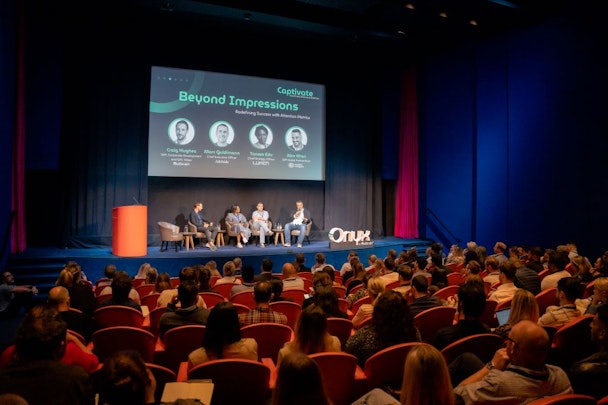Attention, please: how to shift the dial on digital media’s new success metric in 2024
In the third and final part of our series on the art and science of attention, measurement experts predict how marketers will embrace the future digital media success metric.

Industry leaders discuss the importance of attention metrics at Outbrain's Captivate event
In a world where media efficiency is being challenged, the advertising industry is at a pivotal moment - it can choose to stay static with current KPI-driven metrics or move forward and disrupt a status quo by rethinking marketing and media effectiveness to drive better outcomes.
Traditional measurements are a thing of the past - with attention metrics increasingly becoming a tangible way for brands and agencies to redefine success in the digital realm. It’s still early days in the journey towards attention but to shift the dial, the time to start testing is now.
In part one of this series, we looked at the art of attention, where marketing leaders from General Mills, Three UK, Kantar and System1, explored why consistent differentiation is the creative sweet spot to help brands be attention magnets in a distracted world - looking at the key ingredients of creativity to create an ad that’s worthy of audience attention.
Part two delved deeper into the science of attention and metrics, where agency leads from EssenceMediacom, the7stars, Zenith and Resolve, weighed in on a discussion around the correlation between attention and business outcomes, and the deep insight these metrics can provide to help optimize campaigns toward high-quality audience engagement.
Advertisement
A shared understanding of quality
Now the question is where to go from here - more specifically how marketers can start to embrace the art and the science of attention to find the sweet spot to measure and improve on digital media effectiveness.
“90% of what we’re transacting on today is essentially still a display impression and viewability as a filter,” explains Craig Hughes, senior vice-president, corporate development and general manager, video, at Outbrain, who led a discussion on this topic at Outbrain’s recent Captivate event. “There’s no doubt that we’re in the midst of an important evolution away from weak metrics in terms of a connection to an outcome and with attention to a significantly better place.”
These metrics (raw impressions and viewability) are “creating the wrong incentives for small ads on big screens [which are] basically driving low attention,” says Marc Guldimann, chief executive officer, Adelaide. “Getting a shared understanding of what quality actually means is super important to get us out of what’s essentially becoming a lemon market into a place where we can reward high quality publishers for creating high quality advertising opportunities and then we can also give advertisers the justification to pay more for those environments.”
Advertisement
Complementing existing measures
The next step forward on the path to attention as a new currency is to “complement what’s already in place and what systems, measures and models that brands and agencies are working with and are already familiar with,” says Alex Khan, executive vice-president global partnerships, Amplified Intelligence.
“Attention fills gaps and helps color in what is the format that works, on what platform, page, domain or subdomain, so that we’re really helping to drive media efficiencies. That’s ultimately how we move forward, we have to show brands and agencies how attention can help drive media efficiency.”
Media’s job is to create an opportunity for attention and brands are looking for a better understanding of media quality and an easy way to use that to drive better outcomes. Perhaps there hasn’t been enough standardization or consistency yet in the definition of attention - but that’s not necessarily a bad thing, as different clients will have different measures of success.
“We can’t get away from making attention a meaningless currency and metric,” says Tanwa Edu, chief strategy officer at Lumen. “It isn’t just a number that everyone should be aiming at, it is about the KPIs and the objectives. It’s going to be unique to every client based on their starting point and where they want to get to. Don’t all aim for the gold standard. The key thing is to get the optimal amount of attention, but what optimal looks like will be very different.”
Suggested newsletters for you
Testing towards outcomes
Outcomes are going to be affected by attention - and attention is a measurement that doesn’t only look at digital, but multiplatform, across everything within the media and marketing mix. To be able to maximize the effect of that attention, marketers need to have the right building blocks in place and start testing now to understand and learn about the impact it can have.
There’s evidence at the top and bottom of the funnel that attention works. Sharing key advice on what marketers should do next, all reiterate the importance of a test and learn approach to gain an understanding of the cost of incremental outcomes from attention versus today’s metrics.
When marketers know what their KPIs are and understand what they are trying to achieve, “have a look at what’s available on the market for the best solution that will get you close to where you want to be or deliver with what you want from those outcomes and KPIs,” says Khan.
“You can ask for a case study or proof point, but a case study that works for someone else isn’t necessarily going to work for you,” says Edu. “Put your money out there, take that step, test small, learn for your particular challenge. We’re still learning but we know this improvement is a step in the right direction and brings all key stakeholders together. We know media is fragmented and that how we work is too siloed as an industry. Now, suddenly we have something that everyone can get value from and move the dial forward.”
Catch up on the other articles in this series via the links above and to recap on all the sessions from Outbrain’s Captivate: the art and science of attention event, visit here.
Content created with:

Outbrain
Outbrain (Nasdaq: OB) is a leading technology platform that drives business results by engaging people across the open internet. Outbrain predicts moments of engagement...
Find out more
